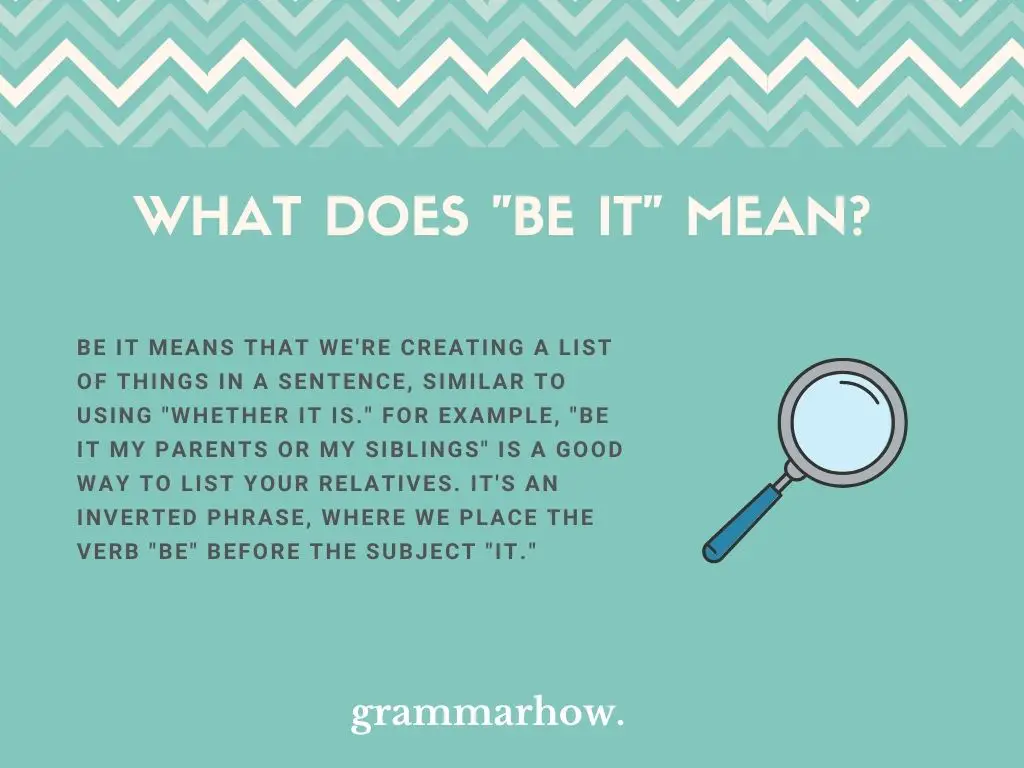Sometimes, old-fashioned idioms and sayings stick with us, and a good example of this is “be it.” It may seem a bit outdated, but it’s still widely used, so what does it mean, and how can you use it in a sentence?
What Does “Be It” Mean?
Be it means that we’re creating a list of things in a sentence, similar to using “whether it is.” For example, “be it my parents or my siblings” is a good way to list your relatives. It’s an inverted phrase, where we place the verb “be” before the subject “it.”

11 Examples Of How To Use “Be It” In A Sentence
It’s one thing us telling you what the meaning is, but it’s another showing it to you in practice. We thought we’d throw together some easy examples to help you wrap your head around it and start using it yourself.
- I love the men in my life, be it my husband, father, or brother.
- Be it on your head when things get challenging, and you didn’t accept my help.
- People will always find ways to disagree, be it social, political, or religious standpoints.
- I love eating meat, be it pork, chicken, or beef.
- There are plenty of interesting subjects at school, be it math, English, or history.
- You may find what you’re looking for in there, be it some good food or simply good company.
- We are very similar people, be it our lack of interest in popular culture or our similar taste in clothing and styling.
- I have so much fun with you, be it when we go out together, when we stay in together, or when we simply text each other for a laugh.
- Work is straining my mental health, be it the long hours or the underappreciation.
- You can’t get what you want without a bit of help, be it from your peers or strangers.
- I like watching movies, be it a comedy, romantic drama, or something in between.
Usually, we follow the phrase “be it” with a list that utilizes the word “or” to compare the things, rather than the word “and.”
Is It “Be It” Or “Beit”?
When we’re using it in this way, we have to say “be it.” There is no reason to ever use “beit” as one contracted word because it doesn’t exist in English.
People get confused because of the contraction “albeit,” which means “all be it” in a similar vein. However, we can’t contract “be it” in the same way, so it must be left as two words.
Is It More Correct To Use “Whether It Be”?
“Whether it be” is the clause that we use when we’re not inverting the verb and the subject. “Be it” initially starts as “whether it be,” making the two phrases interchangeable. It’s up to you which one you use.
There is nothing incorrect with using “be it,” and it works fine in a grammatical sense. The only reason you might prefer using “whether it be” is due to personal choices, and it is up to you which of the two phrases you’d instead use.
Can “Whether It Be” And “Whether It Is” Be Used Interchangeably?
We can look at the phrases “whether it be” and “whether it is” in a similar way as each other. They are also interchangeable phrases, like “be it” and “whether it be.”
The structure of both is the same. We start the sentence with “whether it,” and the only difference is the form of “to be” that we use. Both “be” and “is” are forms of “to be.” “Is” is the third person singular form, while “be” is the infinitive.
While both are technically correct, it’s more common to use “whether it be” when creating a list in the same manner that we’ve mentioned above.
You may also like: “Whether It Be” vs. “Whether It Is” – Difference Explained
Be It – Synonyms
Let’s finish by looking at some alternatives you might be able to use instead of “be it.” If you do not understand the language rules, one of these options might work a little better for you!
- Including
We can start a list in this way, just like “be it.”
- Namely
If we want to be more specific with our list, this one works well.
- That could be
This is a little less common but still a good synonym.
